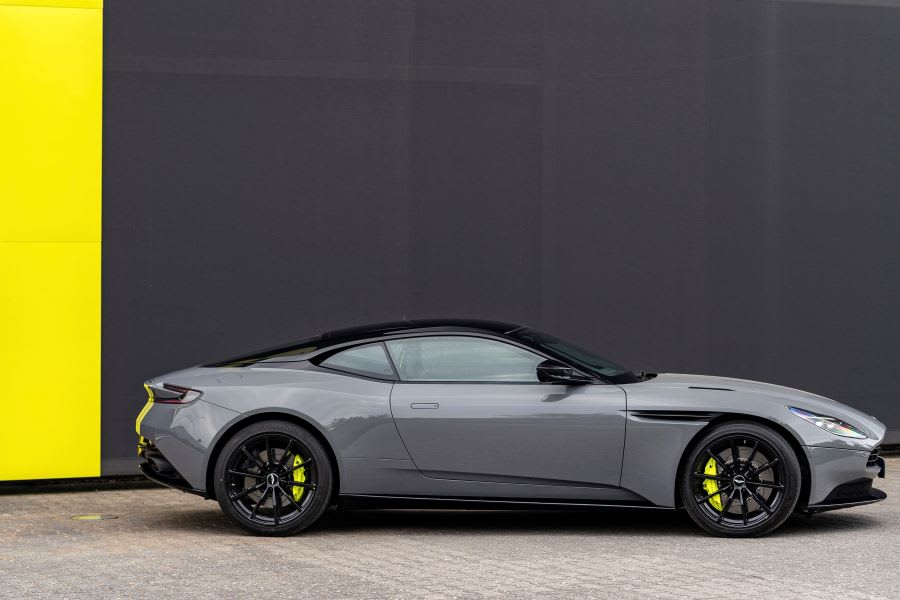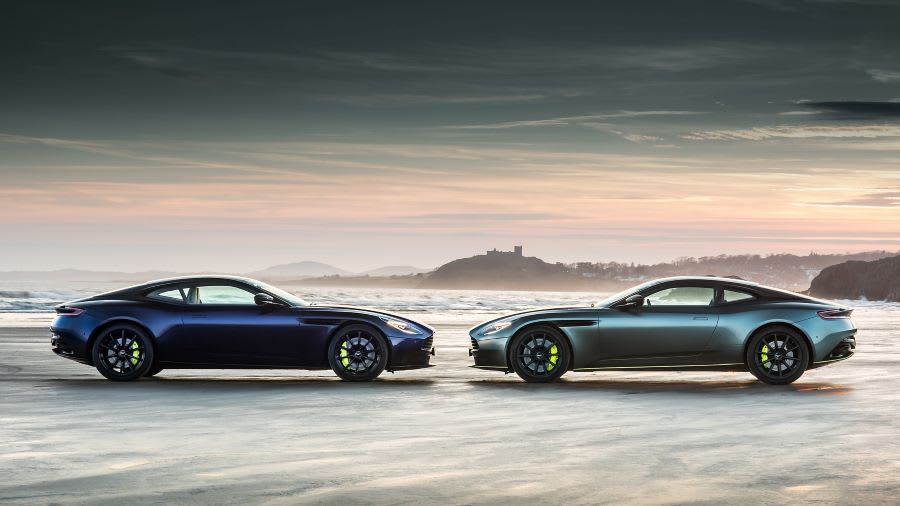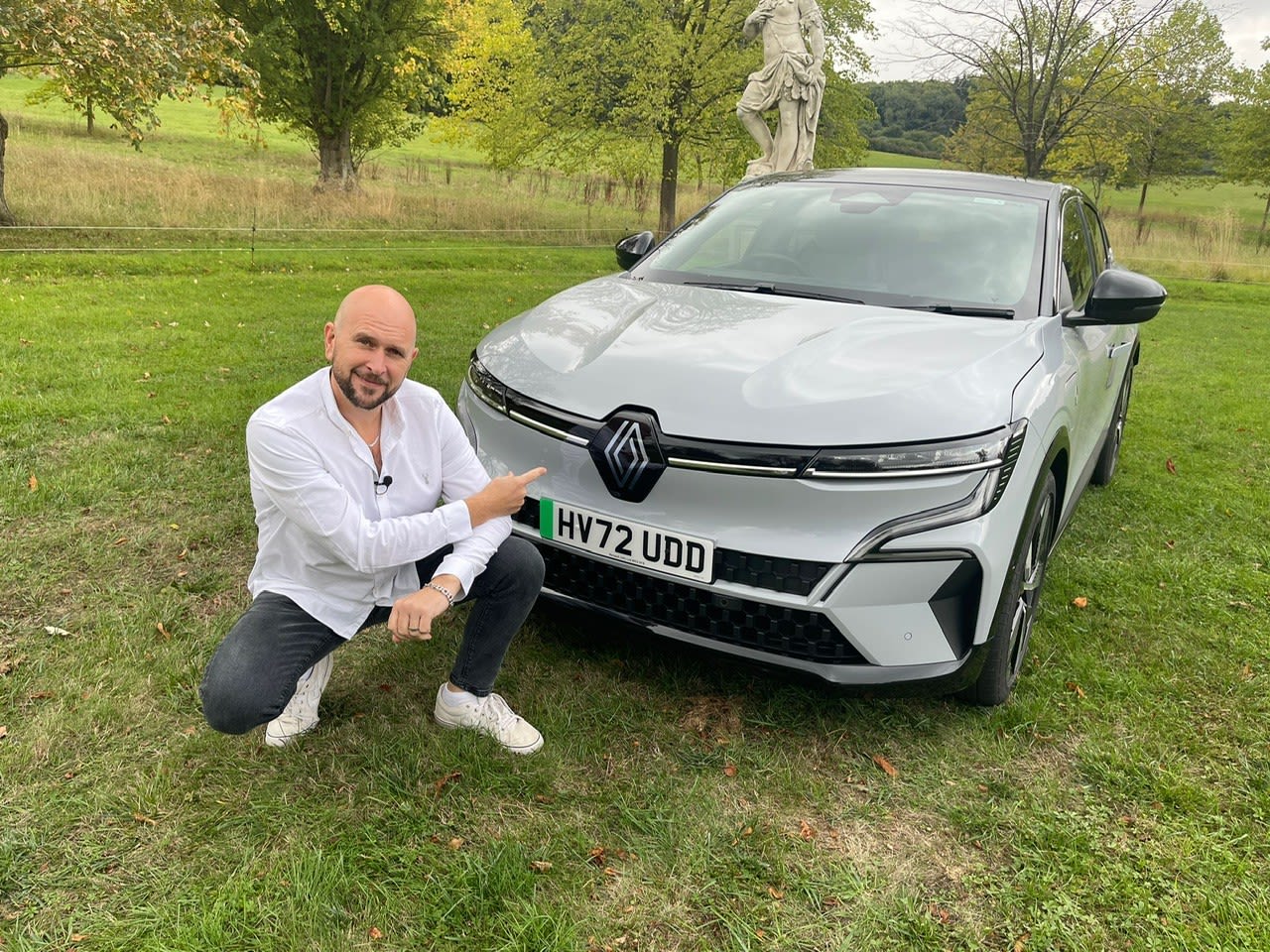.png)
Aston Martin DB11 review
.png)
Introduction
As Daniel Craig waltzes off into the sunset following a glitzy decade-and-a-half playing 007, you can now enjoy fantasies of replacing him in the next Bond film by getting behind the wheel of Aston Martin's latest famed DB car.
The DB11 has been with us for a few years following its 2016 release. But Aston Martin held on to the predecessor DB9 for 12 years, so you shouldn't need to worry about this one becoming yesterday’s car anytime soon.
Select's rating score* - 4.1 / 5
At a Glance
This section might be entitled ‘At a Glance’, but really it should be ‘Don't glance at it otherwise, you won't be able to take your eyes off it without drowning in a sea of your drool'. These Astons should come with disclaimers.
The DB11 is achingly gorgeous to look at, taking clear inspiration from the DB9 but with an evolution in the design.
The front has a pronounced splitter to help with aerodynamics. And, of course, it features the prominent Aston Martin grille, only it's slightly wider and even more of a centrepiece than it was before. In truth, the grille takes up so much room that there's not much to talk about other than the 'kidney-shaped' lights that give it its mean frown. But simple-yet-effective is fine with us.
.jpg)
Side on, the contrast between DB9 and DB11 becomes more apparent, as the DB11's rear overhang is reduced, giving it a shorter look (although it is slightly longer and has a more extended wheelbase). At the same time, pronounced fenders appear as an extension to the front wheel arches, guiding airflow down the side of the car. Flush door handles - and bodywork, which protrudes slightly from the rest of the vehicle towards the front wheels - add to the look.
The rear is vastly different than before, with the number plate moved to the bottom, away from the main bodywork, sitting between the two exhausts. There is also a sizeable, angled indentation across the back, producing a modest spoiler-like effect, with thin strips for the rear lights.
The DB11 is stunning to look at – possibly a step too far for purists. But, in terms of aligning Aston with the modern, cutting-edge technology of James Bond, it does the job well.
.jpg)
Funnily enough, Aston Martin was initially nervous about the DB11 – and understandably so. Despite its reputation as an automotive powerhouse, it was in the doldrums for decades before a long project of upheaval, investment and recovery.
The DB11, then, was the first big project to benefit from this investment, so it’s no wonder Aston described it as the most important car in its history.
What's that, you say? An all-aluminium chassis with magnesium doors? Really, Aston. You needn’t have worried.
.png)
Key Features
You won’t find things as common as ‘trims’ in Aston Martins. Everything is already premium, so there’s no ‘second rate, entry-level’ variant with less garnish.
Instead, you get to choose what flavour garnish you want. This is personalisation at its best – just about everything is customisable, so it's unique to you.
There is a choice of 54 exterior colours for starters (although some do cost extra).
As standard, you get 20-inch wheels, LED lights throughout, a deployable spoiler, a soft-close clamshell bonnet, an electronically controlled exhaust, adaptive dampers, an electronic parking brake and electric folding door mirrors.
The Aston Martin also houses a carpeted cabin, electric steering wheel adjustment, and electric memory heated front seats. In addition, there are front and rear parking sensors, a 360-degree birds-eye view camera, tyre pressure monitoring, dual-zone automatic climate control, and an electronic instrument cluster.
.jpg)
If that's not enough for you, Aston also provides a noise-insulated windscreen, keyless entry and go, automatic parking, an infotainment system with an eight-inch screen, a 400-watt audio system, a digital radio and Bluetooth.
Two engines and two DB11 models are available – the coupe and the Volante convertible. Mind you; the Volante is only available as a V8, which is a 4.0-litre engine producing 639PS, getting from 0-62mph in 3.7-seconds, with a top speed of 208mph.
Pick the coupe, and you can choose to swap the V8 for the V12 AMR engine – a 5.2-litre bi-turbo. It, too, produces 639PS, with a 0-62mph time of 3.7-seconds, topping out at 208mph.
Both come with an eight-speed automatic, although you'll get paddle shifters to feel more like Sebastian Vettel if you want (or Lance Stroll, if you're reading this in Canada).
It is also worth noting that the V12 had around 30PS less power before 2019 – not that that makes it sluggish.
And no prizes for guessing: the DB11 is rear-wheel drive. Of course.

Performance & Drive
We are testing the V12 AMR engine in the coupe.
The DB cars are grand tourers, so they’re built to be cruising machines rather than race-track masters, regardless of the engine and body style. Nevertheless, the DB11 will also perform well around the bends.
Of course, you'll notice the engine noise first, so it makes sense to start there.
Well, this Aston Martin is rapid – and we mean it. The torque is incredible, even at very low revs, so the DB11 surges off the line – and there's next to no turbo lag, either. As a result, it sounds epic with the V12 burbling away, and there's superb performance across the rev range.
The Bridgestone tyres fitted to the car were designed partly for Ferrari as well as the DB11 (they’re even called S-007), but they’re very hard. As a result, the grip somewhat falls off a cliff in the wet.
While driving aficionados might be excited at the thought of going sideways around corners, most will be terrified by this. And while testing on a very soggy day, we could still get wheelspin under acceleration in third gear. But, of course, the car becomes more unpredictable in damper conditions, so this is worth factoring in.
.png)
Nevertheless, the handling is impressive when it's not raining heavily (though this is the United Kingdom).
Some people don't appreciate that Astons aren't generally track-cars – they are built for long-distance cruising. However, people will always judge Astons by the handling, so we're hoping that the DB11 is good. It isn't. It's brilliant.
Astons have rarely handled poorly. But, generally speaking, few supercars can be both cruisers and track-day cars. Usually, it's one or the other. But there is a genuine sense that the DB11 can do both – and do them well.
Ride comfort is on the rigid side, but it wouldn't be a supercar if it weren't. Nevertheless, the adaptive dampers make a huge difference – especially in GT mode – to create a relaxing and comfortable ride that will leave you fresh and alert even after a trans-European jaunt.
You can press a button and go into Sport or Sport+ modes. Both increase the sensitivity of the accelerator pedal and make the throttle more responsive, while you’ll also firm up the dampers. This makes it better at the track-day stuff, although the compromised ride comfort becomes noticeable.
But, despite weighing in at nearly 1,800-kilograms and being GT-focused, the handling is pin-sharp around corners, even when taken at speed.
Aston is known to have poached some leading designers from Lotus. The Norfolk-based automaker is famed of course for its excellent handling sports cars like the Elise and Exige. The influence is clear to see, and the DB11’s versatility shows just how good a job has been done.
Back on the road in GT mode, lumps and bumps are ironed out, and, despite the massive 20-inch alloys, the DB11 doesn't feel like it's having a crash when you hit a pothole. Instead, it feels like it’s holding out a hot iron in front of the car to make the road look as tidy as your best shirt.
.jpg)
The steering is electric-powered and has a responsive feel, full of feedback.
And, during our test drive, regardless of the changeable weather conditions, on the race track or the open road, there was just a sense of satisfaction that Aston had ticked boxes that it hadn't ticked before.
Even aerodynamically, it's ingenious. Aston’s Aeroblade system coaxes airflow into holes within the C-pillar, directing it to the back, where it exits through a slot across the boot lid. This boosts downforce while reducing drag and lift at the same time.
Overall, we were left with celebratory smiles. But, of course, we wanted this to be good. And we're happy to report that the DB11 is luxurious, stylish, sophisticated – and loud. This truly is what an Aston Martin should feel like.
Other Astons are rivalling it now, but it was, without doubt, the best Aston Martin ever at the time of its launch.
.jpg)
Running Costs & Emissions
The V8 manages 25.1mpg, producing 236g/km CO2. However, the extra fuel consumed by the additional four cylinders of the V12 pulls the consumption figure down to 21.1mpg, emitting 265g/km CO2.
Of course, as an Aston Martin, you can expect high maintenance costs, with an annual service likely to cost at least £700.
The V12 is also comfortably in the top bracket for road tax, which means you’ll be paying through the nose to Her Majesty’s Revenue and Customs.
If you are leasing a brand-new Aston Martin, however, it’s unlikely you’ll be in the slightest bit bothered.
.jpg)
Interior & Technology
The interior benefits from Aston Martin's partnership with Mercedes-Benz. This means virtually all the electrics are from the German luxury motor manufacturer, which is no bad thing.
As a result, if you’re driving a Merc now, many things, including the infotainment system and the all-in-one single steering wheel stalk, will be familiar to you.
Admittedly, nothing is particularly new about the Mercedes-Benz bought tech inside the Aston Martin DB11. However, interior gadgetry is moving on so quickly now that other competitors are surging ahead in terms of the quality of their systems.
We suspect this will be high up the list of things for Aston Martin to upgrade soon. But at least the Mercedes-Benz kit feels like a natural fit in the DB11. It certainly doesn’t feel like it’s all been an afterthought of trying to squeeze square pegs in round holes.
.jpg)
The DB11 is a significant improvement on the DB9. Still, Aston has a way to go to match the likes of Bentley. And now that it has all but perfected the car’s performance, we hope the next phase of Aston Martin’s evolution will be to bring the insides up to its rivals’ standards before too long.
The DB11's cabin isn't unpleasant, but there's just a sense that something is missing. It lacks that little garnish of luxuriousness that we were hoping for. However, we can share one tip: the colour scheme seems to make all the difference, so choose wisely.
Even given Aston Martin's shortcomings, there's lots of kit included as standard. Plus (for some reason) a motorised lid for the centre console cubby, in which you’ll find a couple of cupholders and USB sockets.
.jpg)
Practicality & Boot Space
If ever an Aston Martin had a weak spot, it would be this. That said, you can’t enjoy all the creature comforts of a supercar and then expect it to have the cargo capacity of an articulated lorry.
Nevertheless, the DB11 is a four-seater and, for a vehicle of its type, it isn't as bad for practicality as you might think. You will struggle to use all four seats, mind you, unless kids are occupying the back two. But if you are only going a short distance to a restaurant with friends, at least you can try and squeeze a couple of passengers in, rather than send them home on foot.
The DB11 is front-engined, of course, so there is a boot at the back. Its capacity is 270-litres, which may sound tiny, but it isn’t that bad at all. To put it into perspective, it’s only about 20 litres less than you’d get from a Ford Fiesta.
Granted, you will struggle to take the entire family to the airport with their suitcases before jetting off on holiday. But a long weekend away in the DB11 across Europe is doable. Furthermore, the assumption that ‘you can’t go shopping in a supercar’ is well and truly debunked.
.jpg)
Safety
It may not surprise you to learn that Euro NCAP hasn’t crash-tested an Aston Martin DB11. Although Aston assures us it is just as safe as any other quality car out there.
You get dynamic stability control, anti-lock brakes, electronic brakeforce distribution, and emergency brake assist for peace of mind. There is also traction control, hydraulic brake assist, positive torque control, dynamic torque vectoring, automatic parking and blind-spot detection.
.jpg)
Options
The Aston Martin DB11 is as customisable as you want. That said, many things you can choose are included as standard, such as most exterior colours, grille and fender styles.
True optional extras, for which you will fork out more, include the Signature pack, which adds additional finishing touches to the interior (including your very own autograph engraved on a nameplate on the door sills).
You can also get a carbon fibre styling pack for the engine cover and exhaust tips, while boot mats, battery conditioners, car covers and even a luggage set are offered.

Rival Cars
If you are in the market for an Aston Martin DB11, it may be that you're leasing it because it's a DB11 rather than because it's a grand tourer.
In that case, just about any other supercar is a rival.
If you are specifically looking for something designed to go long-distance, a Bentley Continental GT, Ferrari Roma or McLaren GT are worth checking out.
If you fancy something a bit leftfield, then a Polestar 1 might appeal. Or if you don't mind the bulkiness, then a Rolls-Royce Wraith is a car you might not otherwise have taken into account.
Nevertheless, in our view, the Aston Martin DB11 is the pick of the bunch. And, ironically, the only other motor that's likely to give it a run for its money is Aston’s own DBS Superleggera. But, mind you, that's a lot more expensive.
.png)
Verdict & Next Steps
Overall, the DB11 provides the big green tick (and a high-pitched ‘ping’ sound effect) that Aston Martin was desperately hoping for – and badly needed.
It vindicates Aston’s decision to spend tens of millions of pounds upgrading its facilities – and this now finally gives it a stable platform on which to build upwards.
The engines in the Aston Martin DB11 are superb, the car’s quality is excellent, and it's lots of fun to drive with versatility that we haven’t seen elsewhere.
The lack of room in the back makes it difficult unless you have young kids, while the tyres are firm and struggle for grip in the wet, thanks to sheer bucket loads of torque.
Nevertheless, the Aston Martin DB11 is lots of fun to drive. Moreover, it is perfectly capable of a Calais-to-Cannes run across the mainland to the French Riviera.
But, to our surprise, it’s equally as capable of doing a hot lap of Silverstone.
Where to next?
View latest Aston Martin Leasing Deals today!
Looking for a great leasing deal? Check out our incredible range of Special Offers
New luxury sports car? Read our latest Car Reviews and find the right model for you
Want to know more about leasing? Take a look at our comprehensive Leasing Guides
Interested in everything motoring? Why not catch up on all the latest Car Leasing News.
**Score based on Select’s unique meta score analysis, taking into account the UK’s top five leading independent car website reviews of the Aston Martin DB11

















